|
|
|
|
Healthcare and the Medical Profession:

The increasing cost of medical treatment, the lack of effective checks by the state casts doubt on the level of ethics in the medical profession. The healthcare industry doing so admirably in India only enhances these worries. The editorial looks into what might be going wrong when a profession/ industry thrives but there is no improvement in the development indicators associated with it –infant mortality, life expectancy etc.

 Read Read |
|
|
|
|
|
Film: |
|
|
The Tree of Life
(Terrence Malick)

 Read Read |
|
|
|
|
|
India’s ‘Foreign Policy’: A Long way from Bandung |
|
|
Under External Affairs minister SM Krishna, India’s foreign affairs activity seems to have become restricted to registering protests of various sorts – at the indignities suffered by Indians in Australia, at a Russian court’s ban on the Bhagwad Gita in remote Siberia and at SRK being detained for two hours in a US airport. Are India’s foreign policy initiatives directed outward as they should be or are they directed towards influential private interests?

 Read Read |
|
|
|
|
|
|
|
|
|
|
Home > Contents > Article: Marco Polo |
|
|

Local Tourism in India and China
A Study in Contrasts

Marco Polo
|
|
|
|
|
|
|
|
|
|
|
|
Sometimes, visiting another country makes you understand your own better or at least make you see it in different light. For several decades now, I have been a traveler in India but the experience is becoming more and more trying. As a matter of policy I have been choosing never to revisit a place in India and one reason is that there is a sense to be inevitably got that it is degraded somehow, with the deterioration becoming deeply depressing sometimes because this means that one loses even the pleasant memories of a place when one revisits it. Travel is also becoming hugely expensive and India is no longer an economical place to travel in. If one’s requirement of comfort is moderate, it is even cheaper to travel abroad to countries like Turkey and China, which have much more to offer at the same price.
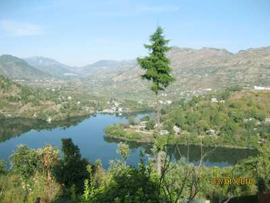
Naukuchiatal Lake |
There has been a huge amount of travel writing in the mainstream media but nearly all of it is highly unreliable. I recollect visiting a lake named Naukuchiatal on the way to Binsar in Kumaon several years ago. This was prompted by a newspaper article in which the pictures made the place look very attractive. I reached the place at night and couldn’t get a good look at the surroundings but the next morning I discovered that the angle from which the pictures in the newspaper article had been taken was the only possible one because even tilting the camera by a few degrees would catch only heaps of discarded plastic waste.
|
Binsar itself is nearly as sorry a place where it does not snow even on New Year’s Eve and paths into what passes for a forest are littered. On the way back, I passed through Corbett National Park in which herbivores had apparently been choking on empty packets of kurkure. This part of Corbett is overrun by tourists and every truck is filled with happy families and fat children chewing on chocolates, popcorn and potato chips, leaving behind a trail of plastic. I learnt that this part of Corbett was not the best one for wildlife. There is another exclusive part where one sights even large carnivores but one needs to make reservations several months in advance.
After Corbett National Park I passed through a part of UP close to Moradabad. In a mustard field late in the evening I saw a grazing animal larger than a cow and the driver informed me that it was a Neelgai. I was so enchanted at seeing an authentic wild animal after the miserable hours spent in India’s premier national park that I got out to photograph it. At that moment a local jeep also stopped abruptly beside me – and I took it to belong to another animal lover. Just then, the Neelgai took it upon itself to gallop across the road and the jeep charged towards it, braking hard when the animal had crossed over to the other side. I then caught my driver gesturing to me to return and I climbed back into my car. The driver told me that the pelts of Neelgais fetch quite tidy sums and since shooting them is a noisy business, skin merchants have hit upon the strategy of running them over. The driver of the jeep had apparently been trying to kill the animal. That was my last attempt to catch Uttaranchal as I remembered it from the 1980s.
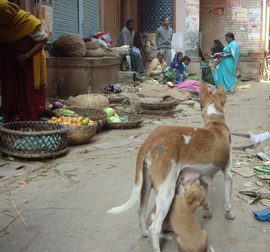
Varanasi |
Progressively, it has begun to seem that India’s top holiday draws – hill stations like Ooty, Kodai, Shimla, Mussoorie, Lonavla, Darjeeling and Manali, seaside spots like Puri, Mamallapuram, Kovalam, Callangute, game sanctuaries like Mudumalai, Bandhavgarh, Nagarhole, scenic pilgrimage centers like Varanasi, Badrinath, Kedarnath, Yamunotri are only ghastly vestiges of what they once were. The farthest reaches of Himachal Pradesh - places like Malana which are only on trekking routes - are places in which tourists look for narcotics. If the state appears to have abdicated, this is not to say that there has been no ‘development’. But ‘development’ apparently means the facilitation of free enterprise - the indiscriminate granting of licenses to five star
|
resorts to open up in the most unspoiled spaces and turning a blind eye to the illicit ancillary businesses which mushroom around them. There are even (perhaps not entirely reliable) accounts of game being offered in cheap eateries around our national parks with the endorsement of leading Bollywood stars. The process underway is to allow public spaces to deteriorate so that private enclosures will thrive and this is something we see in every field - the public education system destroyed so that private education becomes lucrative, the end of public health so that private hospitals make money.
Ever since 1991-92 the state’s emphasis in India is to make every activity ‘viable’ and ‘sustainable’ but there is an accounting malpractice which is deliberately allowed - which makes free enterprise appear viable when it is clearly not so. This is that when private enterprise makes use of resources in the public realm - pure air, clean water, pristine landscapes - they are allowed to use and exhaust them while assigning only ‘zero value’ to their use. A chemical plant is allowed to pollute the air and water without being made to pay for the ecological damage it causes. A similar thing is happening in the tourism industry. An untouched spot in the depths of the jungle is allowed to a five star resort and the influx of tourists destroys its pristine nature. Private enterprise has gained at the expense of the nation’s heritage - something we hold in common – and the nation’s heritage is depleted although shareholder value perhaps goes up correspondingly for the investor. Such accounting malpractices have perhaps gone a long way in making Indian industry ‘globally competitive’.
If we recollect the words of our national anthem, the geography of India is something all of us should hold dear but our hills and mountains are being quarried away and our waterfalls are polluted. Would we not require all these assets to be maintained in their pristine state for us to relate to the nation’s geography as something sacred? Do the geographical/natural/cultural assets of the nation not need to be maintained by the state instead of being gifted away? Local tourism is a good thing because people see parts of the nation to which they do not belong and feel oneness with them but India’s heritage is now seriously threatened.
India and China are both huge countries with large racially diverse populations and it will be interesting to look at local tourism in China. Being a first-time visitor in a country may not place one in an advantageous position to understand aspects of its political life but if one thing stood out during a trip to Yunnan province, it is the steps taken by the Chinese state to foster a nation. A nation is not created out of nothing because the citizenry need emblems which will enable them to imagine a single nation – religion, history, customs, culture and even geographical wonders. Since China is such a vast space with ethic, cultural, racial and economic differences, the Chinese state is apparently conscious of this and is taking conscious steps to minimize the possibility of future disaffection. On our first evening in Kunming, the capital of Yunnan province, we were treated to a song and dance spectacle entitled ‘Dynamic Yunnan’. Yunnan is home to 51 of China’s

'Dynamic Yunnan' performance |
55 minority groups and ‘Dynamic Yunnan’ is a medley which showcases most of these cultures without sparing any effort. The show was directed by Yang Liping a dancer from the Bai minority group from Xishuangbanna in south-west Yunnan. Yang began her career at the age of 13 and has been dancing for over 30 years. To be candid, ‘Dynamic Yunnan’ is perhaps a little kitschy - the chief attractions in it being romances between young people, religious faith and asceticism, nature’s bounty with flowers and peacocks, the show even arranging for the
|
dancers to be soaked in a simulation of rain. The show concluded with Yang as the lead dancer doing a peacock dance. The stage was a vast expanse and, at any moment, fifty dancers or more moved perfectly together to elicit the desired effect. Although one was acutely conscious that what one was seeing was directed at the lowest common denominator, the perfection displayed and the energy on the stage made the show strangely moving. It was perhaps the sense that we were joining in celebrating something commonly with other people rather than experiencing an esoteric pleasure. To my mind, the Festivals of India - which were too elitist to draw a large enough public across the nation - have concluded and there is nothing even faintly comparable to ‘Dynamic Yunnan’ in India, a celebratory performance deliberately created to draw in a large enough public.
A few days later in Dali town, we found that a show similar to Dynamic Yunnan was being held in the open air with an actual snow mountain as backdrop and the show was being directed by Chen Kaige, who along with Zhang Yimou has been the best known filmmaker to emerge from China. It is apparent that the best talent is being enlisted to showcase Chinese culture to the local public. Except for its charming old town with its teeming night life Dali itself is an unmemorable city but there were hordes of tourists everywhere - not foreigners but Chinese from the different corners of the country. The chief attractions in Dali are three pagodas, the oldest of
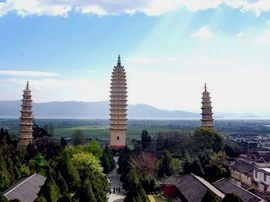
Pagodas of Chongsheng Temple |
which is around 1000 years old. But around these three refurbished pagodas of Chongsheng Temple, the Chinese state has constructed an enormous Buddhist complex about twenty years ago. There are impeccably kept gardens around the complex, which is so large that electric cars have been arranged to ferry thousands of visitors every day. There are several shrines in the complex, none of them ancient but here again it is evident that visitors are being drawn in and do not leave without being impressed. A few miles away is Xizhou village where a special ‘tea ceremony’ is arranged – everyone is served three different kinds of tea even as a dance is
|
performed by young people. There is a story accompanying the tea drinking about matchmaking and finding brides. There is little doubt that the ritual has been recently invented and that the structure in which all this takes place is a new one intended to replicate a traditional palace but all this is still bringing in huge numbers of Chinese tourists. A few days later in Dali town, we found that a show similar to Dynamic Yunnan was being held in the open air with an actual snow mountain as backdrop and the show was being directed by Chen Kaige, who along with Zhang Yimou has been the best known filmmaker to emerge from China. It is apparent that the best talent is being enlisted to showcase Chinese culture to the local public. Except for its charming old town with its teeming night life Dali itself is an unmemorable city but there were hordes of tourists everywhere – not foreigners but Chinese from the different corners of the country. The chief attractions in Dali are three pagodas, the oldest of which is around 1000 years old. But around these three refurbished pagodas of Chongsheng Temple, the Chinese state has constructed an enormous Buddhist complex about twenty years ago. There are impeccably kept gardens around the complex, which is so large that electric cars have been arranged to ferry thousands of visitors every day. There are several shrines in the complex, none of them ancient but here again it is evident that visitors are being drawn in and do not leave without being impressed. A few miles away is Xizhou village where a special ‘tea ceremony’ is arranged - everyone is served three different kinds of tea even as a dance is performed by young people. There is a story accompanying the tea drinking about matchmaking and finding brides. There is little doubt that the ritual has been recently invented and that the structure in which all this takes place is a new one intended to replicate a traditional palace but all this is still bringing in huge numbers of Chinese tourists.
In another corner of Yunnan is a natural wonder - a ‘stone forest’ measuring 350 sq.km at Shilin in which basalt formations resemble a petrified forest. This was inhabited by local people (the Yi minority) a year or two ago until the people were evicted and resettled nearby. The stone forest has been cordoned off and freshly paved - so that 150 electric cars can ferry the four million visitors who arrive and depart every year. The site is so scrupulously tended that I saw a middle aged woman in the afternoon sun entrusted with extracting cigarette butts and minute bits of plastic out of crevices between the stone slabs in the car park with a pair of tweezers!
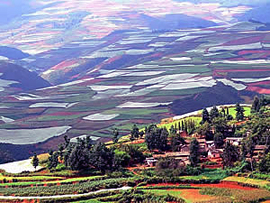
Dongchuan Red Earth |
Some attractions stands out in a visit to Yunnan and two of them are in Dongchuan in the north-east and Yuangyang in the south. These are basically sites in which farming is being practiced but which are also stunningly beautiful as landscapes. Dongchuan is famous for its red earth with the land around it being hilly and this means that the area has been carved up into fields at different levels with the entire area being scrutinizable from certain vantage points. Making the whole panorama gorgeous in an indescribable way are the strips of plastic used by farmers to protect the sprouting plants and help retain the moisture in the soil. From a distance these
|
strips of plastic glint in discrete rows amidst the fields around which have been neatly cut out and terraced. As strikingly beautiful as Dongchuan are the 800-year-old rice terraces in the vicinity of
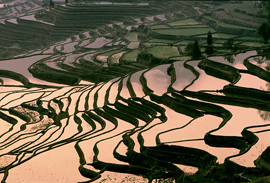
Yuangyang Rice Terraces |
Yuangyang ancient town. Yuangyang, again, is hilly terrain – perhaps more so than Dongchuan with individual rice terraces arranged on the hillside like scales on a reptile’s back and (on clear days) stretching out as far as the eye can see. A visit to a terrace reveals that every square foot of land has been scrupulously used. Since the land is not flat, buffaloes are still immensely useful. Statues of a buffalo with a rice farmer stand at the centre of Yuangyang ancient town. Dongchuan and Yuangyang house farming communities but they are huge tourist attractions. Photographers from across
|
China arrive to take pictures of the sites. A site of intense agricultural production as a tourist attraction is not something that one often expects.
When a mineral is discovered in an environmentally sensitive spot, special measures are needed to protect the latter. Tungsten has been discovered in the mountains alongside Tiger Leaping Gorge, a celebrated trekking route and mining has begun. What I discovered there, however, was only pure, dust-free air and two PVC pipes transporting slurry to a refining plant a couple of thousand feet below. It is obviously not impossible to mine in eco-sensitive spots without destroying them. But our own mining lobbies will not take the necessary steps because they consider them too expensive. They compensate by dressing up data with assistance from our officials and planting huge advertisements on television announcing to the public that they are in the business of ushering in ‘happiness’.
Judging from the private hotels proliferating, enterprise thrives in China but it is kept in check. In terms of tourism, private hotels are located far away from the sights and there is little danger of private enterprise destroying commonly owned national assets. In Yuangyang, for instance, allowing a resort at a vantage point could easily block one of the streams watering the terraces. The state collects hefty fees towards the upkeep of some attractions but they are maintained so well that the earnings may not be adequate to meet all the expenses. Still, nation building appears to be a primary concern and it is perhaps to this end that internal tourism is being used.
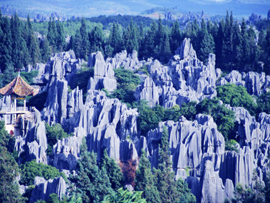
Shilin Stone Forest |
At the same time, local tourism may also help redistribute incomes across China because there is a huge gap between what people in the developed areas in the east and Yunnan earn which needs to be bridged. Everyone in China is accountable. Our departure from a state owned hotel in Shilin was delayed because the cleaning woman could not find a drinking glass which should have been on a shelf in the bedroom. We were allowed to leave only after it was located in a corner. If there is a lesson to us as Indians in all this, it is the desperate need for nation building in a land as extensive as India’s or
|
China’s and importance of the strong state in maintaining the nation.
There will always be rhetoric that people must ‘change from within’ which probably cites Mahatma Gandhi. But judging from the relative conduct of people in China and India, it would seem that the state plays an enormous role in endowing the public with the right attitudes. In India, the encouragement extended to private enterprise after 1991-92 without reigning in the worst impulses of our entrepreneurs has seen the nation’s heritage being progressively compromised. It would seem that if we are to remain a nation with more than cricket and Bollywood to keep us together, the state will need to play a larger role in the upkeep and maintenance of the nation (and its heritage) regardless of what the laissez-faire economists in charge of its policies may argue. If this nation is to be a more inclusive one, this means the tending to of public spaces rather than the creation of private enclosures.


Marco Polo is an Indian writer who travels for his livelihood.


|
|
|
|
|
|
Top |
|
|
|
|
|